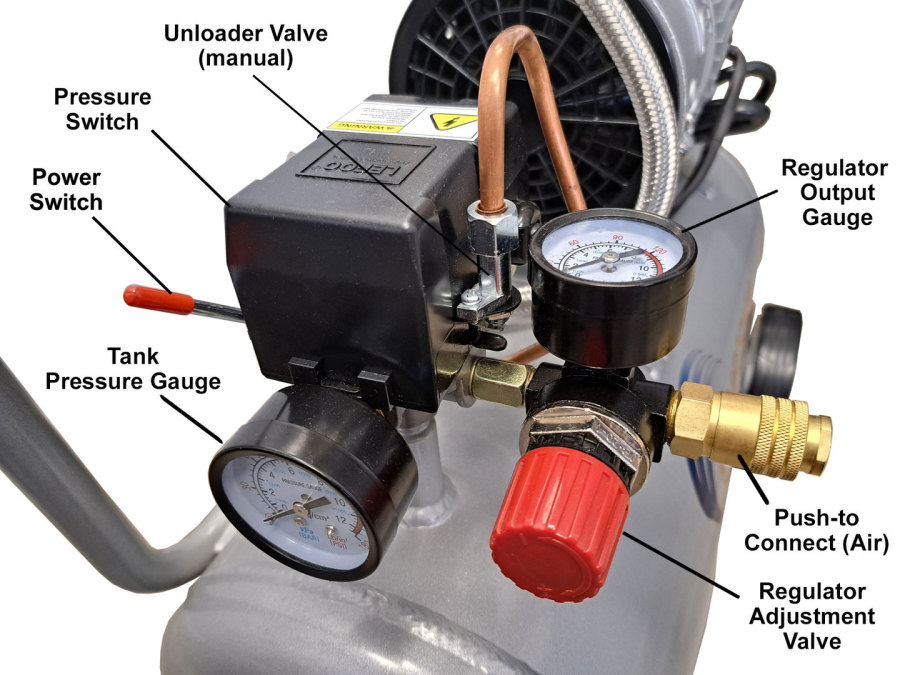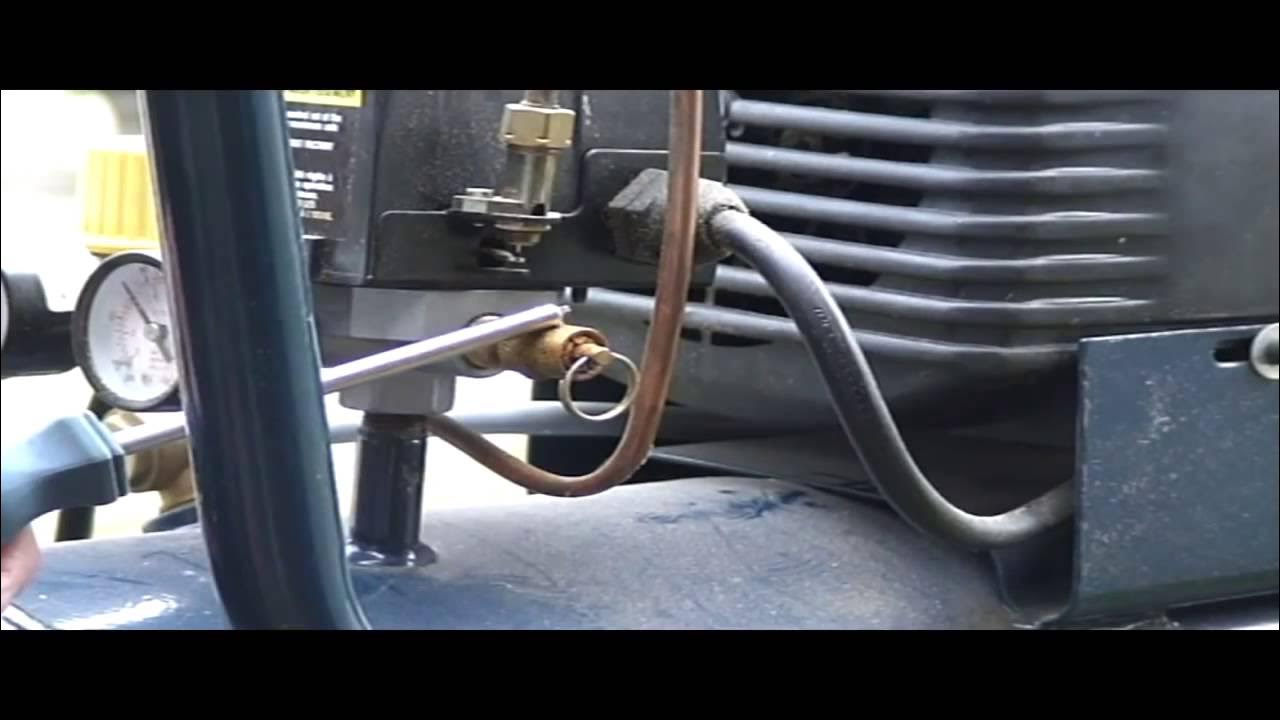The air compressor pressure release valve prevents over-pressurization by venting excess air. It ensures safe operation and protects the compressor from damage.
Air compressors are vital tools in various industries, from construction to automotive. They compress air for powering tools, inflating tires, and more. A crucial component of these machines is the pressure release valve. This valve plays a key role in maintaining safe operating pressure levels.
It automatically releases air when pressure exceeds a set limit, preventing potential hazards. Understanding the function of this valve can enhance safety and efficiency. Regular maintenance of the pressure release valve ensures optimal performance and extends the lifespan of the compressor. Knowing how it works helps users prevent equipment failure and improves overall productivity.
Introduction To Air Compressor Safety
Air compressors are powerful machines. They help in various tasks, from inflating tires to powering tools. However, safety is a major concern. Knowing how to maintain your air compressor can prevent accidents and injuries.
Importance Of Regular Maintenance
Regular maintenance keeps your air compressor running safely. Neglecting maintenance can lead to serious problems. Here are key points to remember:
- Check for leaks regularly.
- Change oil as needed.
- Inspect hoses for wear and tear.
- Clean filters to ensure airflow.
By staying proactive, you can extend the life of your compressor. Regular checks save time and money in the long run.
Role Of Pressure Release Valves
Pressure release valves are crucial for air compressor safety. They prevent over-pressurization, which can cause explosions. Here’s how they work:
| Function | Description |
|---|---|
| Release Excess Pressure | Automatically opens to release air when pressure exceeds limits. |
| Prevent Damage | Protects the compressor from damage due to high pressure. |
| Ensure Safe Operation | Maintains safe operating levels for users and equipment. |
Inspect pressure release valves regularly. Ensure they are functioning correctly. This simple step can save lives.
Understanding Pressure Release Valves
Pressure release valves are vital components in air compressor systems. They ensure safety and efficiency. Knowing how they function and the types available is essential for users.
Function In Air Compressor Systems
The primary role of a pressure release valve is to manage air pressure. Here are key functions:
- Safety: Prevents over-pressurization.
- Protection: Shields equipment from damage.
- Efficiency: Maintains optimal performance.
When pressure exceeds a set limit, the valve opens. It releases excess air. This action stabilizes the system.
Types Of Valves Used
Different types of pressure release valves serve specific needs. Here are the main types:
| Valve Type | Description | Common Uses |
|---|---|---|
| Manual Relief Valve | Requires manual operation to release pressure. | Small compressors, maintenance tasks. |
| Automatic Relief Valve | Automatically releases pressure when needed. | Larger systems, continuous operation. |
| Pop-off Valve | Quickly releases pressure in emergencies. | Safety applications, high-risk environments. |
Choosing the right valve is crucial. Consider the system’s requirements and safety standards.
Installation Guidelines
Installing an air compressor pressure release valve correctly is crucial. A proper installation ensures safety and efficiency. Follow these guidelines to achieve a successful setup.
Selecting The Correct Valve
Choosing the right valve is essential for optimal performance. Consider the following factors:
- Pressure Rating: Ensure the valve can handle your compressor’s maximum pressure.
- Size: Match the valve size to your compressor’s outlet.
- Material: Choose durable materials like brass or stainless steel.
- Type: Decide between manual and automatic release valves.
Steps For Proper Installation
Follow these simple steps for a proper installation:
- Gather Tools: You will need a wrench, thread seal tape, and the new valve.
- Turn Off Power: Disconnect the compressor from its power source.
- Release Pressure: Open the drain valve to release any stored air.
- Remove Old Valve: Use a wrench to unscrew the old valve.
- Prepare Threads: Wrap thread seal tape around the new valve’s threads.
- Install New Valve: Screw the new valve into place, tightening securely.
- Reconnect Power: Plug the compressor back into the power source.
- Test Functionality: Run the compressor and check for leaks.
Proper installation ensures safety and enhances performance. Follow these guidelines closely for best results.

Credit: www.californiaairtools.com
Routine Inspection And Maintenance
Regular inspection and maintenance of the air compressor pressure release valve are crucial. This helps ensure your equipment runs smoothly and safely. Neglecting these tasks can lead to costly repairs and safety hazards.
Inspection Frequency
Inspect your air compressor pressure release valve every month. More frequent checks may be necessary in high-use environments. Use the following table for guidance:
| Usage Level | Inspection Frequency |
|---|---|
| Low Use | Every 3 months |
| Moderate Use | Every month |
| Heavy Use | Every two weeks |
Maintenance Procedures
Follow these maintenance procedures to keep your valve in top shape:
- Clean the Valve: Remove dust and debris monthly.
- Check for Leaks: Inspect connections for air leaks.
- Test the Valve: Manually open and close the valve.
- Inspect Seals: Check for wear or damage.
- Replace if Necessary: Change seals or the valve as needed.
Document each inspection and maintenance activity. This helps track the condition of your equipment. Keeping records can also aid in troubleshooting.
Common Issues And Troubleshooting
Air compressor pressure release valves can face several issues. Identifying these problems early helps maintain performance. Here are common failures and steps to troubleshoot them effectively.
Identifying Valve Failures
Watch for these signs of valve failure:
- Air leaks: Listen for hissing sounds.
- Pressure drops: Monitor gauge readings closely.
- Overheating: Feel the compressor for excessive heat.
- Valve sticking: Check if the valve moves freely.
Understanding these symptoms helps you act quickly. Ignoring them may lead to bigger problems.
Troubleshooting Steps
Follow these steps to troubleshoot your valve:
- Turn off the compressor: Always prioritize safety.
- Inspect the valve: Look for dirt or debris.
- Clean the valve: Use a soft brush and cloth.
- Check seals: Ensure they are intact and not worn.
- Test the valve: Reassemble and run the compressor.
If problems persist, consider replacing the valve. Sometimes, a simple fix can save money.
| Issue | Possible Cause | Solution |
|---|---|---|
| Air leaks | Worn seals | Replace seals |
| Pressure drops | Faulty valve | Replace valve |
| Overheating | Poor airflow | Check vents |
| Valve sticking | Debris buildup | Clean valve |

Credit: compressor-source.com
Safety Protocols During Operation
Safety is crucial when using an air compressor. Proper protocols help prevent accidents and ensure smooth operation. Understanding these safety measures can protect users and equipment.
Operating Guidelines
Follow these operating guidelines for safe air compressor use:
- Read the Manual: Always start by reading the manufacturer’s manual.
- Inspect Equipment: Check for leaks, cracks, or damages before use.
- Wear Protective Gear: Use safety goggles and ear protection.
- Keep Area Clear: Ensure the workspace is free from clutter.
- Proper Connection: Securely connect hoses and fittings.
Operating an air compressor requires attention to detail. Maintain a safe distance from the exhaust and avoid touching hot surfaces. Always ensure the pressure release valve is functioning properly.
Emergency Procedures
Prepare for emergencies with these procedures:
- Shut Off Power: Immediately turn off the compressor.
- Release Pressure: Use the pressure release valve to lower pressure.
- Evacuate Area: Clear the area of all personnel.
- Call for Help: Contact emergency services if needed.
Keep a first aid kit nearby. Regularly practice these emergency procedures. This preparation helps everyone respond quickly in a crisis.
| Action | Details |
|---|---|
| Inspect Equipment | Check for visible damage or wear. |
| Wear Gear | Use protective eyewear and earplugs. |
| Clear Workspace | Keep the area free of obstacles. |
| Emergency Contact | Have emergency numbers accessible. |
Following these safety protocols ensures a secure and efficient operation. Stay alert and prioritize safety at all times.
Legal And Compliance Considerations
Understanding legal and compliance issues is crucial for air compressor safety. The pressure release valve plays a key role. It ensures safe operation and prevents accidents.
Industry Standards
Various industry standards guide the design and use of pressure release valves. Compliance ensures safety and reliability. Key standards include:
- ASME Boiler and Pressure Vessel Code: Covers pressure vessel safety.
- ISO 9001: Focuses on quality management systems.
- OSHA Regulations: Ensures workplace safety and health.
Manufacturers must follow these standards. Regular updates ensure valves meet safety requirements.
Compliance And Auditing
Regular compliance checks are essential for air compressor systems. Audits help identify risks and ensure safety protocols are in place. Consider the following steps:
- Conduct periodic inspections of pressure release valves.
- Document all findings and corrective actions.
- Train staff on safety procedures and compliance requirements.
- Review compliance reports regularly for improvements.
Staying compliant reduces legal risks. It also protects workers and equipment. Regular audits promote a culture of safety.

Credit: www.youtube.com
Advancements In Valve Technology
Technology in air compressor pressure release valves is evolving rapidly. These advancements focus on improving efficiency and safety. Manufacturers are adopting innovative designs to meet industry standards.
Innovations In Safety
Safety is a top priority in valve technology. New designs incorporate multiple features for enhanced protection. Below are some key innovations:
- Automatic Reset Mechanisms: These valves reset automatically after pressure is released.
- Pressure Sensors: Sensors alert users of abnormal pressure levels.
- Durable Materials: High-quality materials resist corrosion and wear.
| Feature | Benefit |
|---|---|
| Automatic Reset | Reduces manual intervention needed |
| Pressure Sensors | Enhances user awareness and safety |
| Durable Materials | Increases lifespan of the valve |
Future Of Pressure Release Valves
The future of pressure release valves looks promising. Innovations aim to improve both functionality and safety. Key trends include:
- Smart Technology Integration: IoT-enabled valves will monitor pressure in real-time.
- Eco-Friendly Designs: Sustainable materials will reduce environmental impact.
- Enhanced User Interfaces: User-friendly controls will simplify operation.
These advancements will make air compressor systems safer and more efficient. The focus remains on protecting users while enhancing performance.
Frequently Asked Questions
What Is A Pressure Release Valve For Air Compressors?
A pressure release valve is a safety device in air compressors. It helps prevent excessive pressure buildup by releasing air when it exceeds a set limit. This ensures safe operation and protects both the compressor and users from potential hazards.
Regular maintenance of this valve is essential for optimal performance.
How Does A Pressure Release Valve Work?
The pressure release valve operates by monitoring the air pressure inside the compressor. When the pressure reaches a predetermined level, the valve opens to release excess air. This action prevents damage to the compressor and maintains safe operating conditions. Understanding its function is crucial for effective compressor usage.
Why Is My Compressor’s Pressure Release Valve Leaking?
A leaking pressure release valve may indicate wear or damage. It can also be caused by debris or corrosion inside the valve. Addressing this issue promptly is essential to maintain compressor efficiency and safety. Regular inspections can help identify and rectify potential problems early on.
How To Adjust The Pressure Release Valve?
To adjust the pressure release valve, locate the adjustment screw on the valve. Turn the screw clockwise to increase pressure or counterclockwise to decrease it. Always consult the manufacturer’s guidelines for specific instructions. Proper adjustment ensures the compressor operates efficiently and safely under various conditions.
Conclusion
Understanding the role of an air compressor pressure release valve is essential for safe operation. Regular maintenance ensures optimal performance and longevity of your equipment. By following proper guidelines, you can prevent potential issues. Prioritize safety and efficiency to enhance your overall experience with air compressors.
Invest in knowledge for better results.

